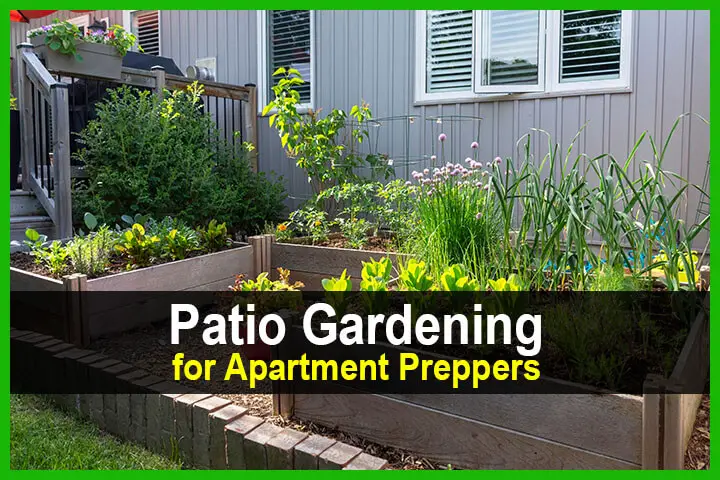Estimated reading time: 12 minutes
Anyone living in an apartment is well aware of the obvious limitations when it comes to something like gardening. Most apartment dwellers have only a patio at best, and even people who live on the first floor usually can’t extend a garden into lawns surrounding the building.
The solution many apartment dwellers have pursued is a patio garden. It seems to have minimal opportunities at first, but there are some innovative ways to grow a robust amount of vegetables and herbs on a small patio.
One of the best solutions is vertical gardening, which uses designed structures to grow vegetables up rather than across a limited amount of horizontal space. But there’s more to it than that.
Equipment and Supplies for Patio Gardening
There’s a range of equipment and supplies designed to make the most of limited space in any garden. Most are available at home centers or on Amazon and can be used season after season. They can all be used in combination to create the maximum use of space on a small patio.
Stacking Pots
Stacking pots usually feature levels of pots stacked one on top of the other. Each pot level is usually 3 pots fused together with grooves cut in the bottoms to stack the levels one on top of another. They can be stacked up into 2, 3, 4 or more levels and allow each plant enough room to grow and get enough sunlight.
The design of these pots also help with watering. The bottoms of each pot has drainage holes and any drainage from the top pots percolates into the pots beneath. Each pot should still be watered but it’s nice to know any excess water will be cycled into the lower pots.
It’s also wise to rotate the stack from time to time to make sure all plants get some exposure to full sun. We’ll cover some options for people living in apartments with a northern exposure later on in the article.
The best vegetables to grow in stacking pots include herbs, root vegetables, and strawberries.
Terraced Trays

Terraced trays are long trays that are stacked on a stand at an angle creating terraces of trays. It allows you to actually plant vegetables in rows like some people do in gardens.
Terraced trays are often used for planting green, leafy vegetables, herbs, onions and even shallow root vegetables like radishes, beets, onions and turnips. The key is to take note of the root depth of any vegetable at maturity. The trays on terraced trays tend to be somewhat shallow ranging from 6 to 8-inches of soil depth.
Mini Trellises
Mini trellises can be as simple as some lattice stuck into a large pot to more ambitious designs that angle a double-sided trellis across long trays at the bottom. Mini trellises can be put towards the back of a patio because the vegetables that grow up the trellis will still get sunlight even if there are pots placed at its base.
The best vegetables for a mini trellis are the vining vegetables. These include tomatoes, cucumbers, squash, eggplant, pole beans, and peas.
Large Pots and Half Barrels
The benefit of a large pot or half barrel is the soil depth. This allows for growing deep rooted vegetables like carrots, parsnips, or any other vegetables with deep roots.
You could also plant multiple plants in larger pots or half barrels. Consider planting a half dozen pepper plants or 3 or 4 tomatoes. You could even combine different vegetables in the same large pot. We’ll cover more about things like companion planting and square-foot gardening in a moment.
Hanging Baskets and Pots
The ability to hang pots or baskets creates a whole new level of gardening opportunities above any planters sitting or propped on the patio.
Some pots or baskets can be hung over a railing although you’ll want the pot hanging inside the railing to avoid any overflow or spillage from dripping to patios or the ground below when watering.
Hanging pots can also be suspended in levels with some hanger configurations allowing more than one pot to be suspended one above the other.
The best vegetables for hanging pots and baskets are smaller varieties like leafy greens, herbs, strawberries and even onions and garlic due to their shallow root systems. However, don’t hesitate to plant pepper plants and even cherry and grape tomatoes in any hanging pot or basket.
Best Vegetables for a Patio Garden

The best vegetables for a patio garden tend to be the smaller varieties. This gets back to choices like cherry and grape tomatoes. Smaller plants do better in a small space and many of them produce average to large size fruits and roots so don’t feel like you’ll be growing in miniature.
Dwarf Varieties
There are dwarf varieties of fruit trees that will survive and thrive in a large pot or half barrel include varieties of oranges, lemons, tangerines, blueberries, cherries and even some olive tree varieties.
You probably don’t want to plant more than one or two dwarf trees, but they’re worth thinking about if you want some fruits in addition to your vegetables.
There are also dwarf varieties of vegetables although they are sometimes not designated as “dwarf.” Look at the growing height and root depth to see if a variety will fit in your patio garden. Many pepper and tomato plants grow into a compact size. Just avoid the obvious giants like Beefsteak tomatoes although even a Beefsteak tomato plant can grow in a patio garden if pruned from time to time.
Vining Vegetables
If you have a trellis set up or even a large stake in a pot, you can train and grow vining vegetables. This includes cucumbers, squash, smaller melon varieties like dwarf watermelons, eggplant, and especially pole beans and peas.
Just make sure you look at the seed packets to see what the needs are for the variety. Avoid the jumbo varieties that might require significant soil depth, watering and feeding.
Shade Tolerant Herbs and Vegetables
Every garden gets a certain amount of shade but some patio gardens have a unique challenge when it comes to shade. Anyone living on the north side of an apartment building will simply not see direct sunlight. That doesn’t mean a patio garden is impossible, but you’ll have greater success with shade-tolerant vegetables on a patio with a northern exposure.
Here again, read the seed packets if in doubt or do some research. Here’s an article that covers the subject of shade tolerant fruits and vegetables like kale, cabbage, broccoli, Brussels sprouts, cauliflower and others.
High Yield Vegetables
Some vegetable varieties yield more than others. The key is to focus on the vegetables that will give you the highest yield in any season. Sometimes this is the result of a vegetable plant producing massive amounts of fruits at one time, while others continue to produce more blossoms and fruits over the lifecycle of the plant.
The wise thing to do is to find and plant those vegetables that give you the most in return. When space is limited it makes sense to get the most you can with what little you have.
Best Practices for Patio Gardens

One of the keys to successful patio gardening is applying the best gardening practices. When space is valuable you need to value every square foot. Here are some techniques many experienced gardeners apply to make the most of every season.
Companion Planting
Companion planting is when you intentionally plant two different varieties of plant next to each other. This is done because the plants actually have a symbiotic relationship that helps each plant grow healthier and stronger.
Then again, there are some plants that are not compatible and should not be planted together. It’s always worth considering the implications of companion planting in any garden, but it’s especially important in a patio garden.
If you have more than one variety of plant sharing the same pot or container, the roots will not only intertwine, but any chemical compounds released by the plants will interact with surrounding plants. This is all magnified in the close proximity of a shared pot or container. Here’s an article that covers the subject of companion planting quite well, and the telegram is “watch where you plant the onions and garlic.”
Succession Planting
Succession planting is when you plant more than one crop in a season. This is easily done with fast maturing vegetables like radishes, beets, green onions and some varieties of green, leafy vegetables.
When your garden space is limited you can still increase your yield with succession planting. Better yet, if you take any of your patio garden indoors in colder weather you can continue to plant and harvest crops with fast maturing vegetables. Here’s more information on the concept with extended detail:
Square Foot Gardening
Square foot gardening is exactly what it says. It’s all about clustering plants properly in a small space to maximize the available soil and space to get the best yield.
It combines many of the practices we’re covering here including companion planting and the best varieties for what is essentially a high-density garden. It’s an excellent practice in a patio garden where a square foot becomes the common measure for any planting plot. Here’s what you need to know:
Regular Feeding and Watering
Patio gardening is all about container gardening. Everything you plant is growing from a container in some way, shape or form. There are a lot of benefits including the ability to move plants indoors in cold weather; rotate them to receive 360 degree sun, move them into or out of the rain, or to simply rearrange them so they’re easier to care for as they mature.
However, there’s also a downside. Containers don’t hold and keep water all that well. They’re above ground and don’t have the benefits of deep saturation of water that you would find in a traditional garden. The containers are also exposed to sunlight and the wind. Both combine to cause rapid evaporation of any water in the pots.
As a result, frequent watering is recommended. There are other practices like wicking beds and top mulching that can also help your patio garden get through a dry spell.
And then there’s feeding. It’s best to use a rich potting soil of 1 part peat moss, 1 part compost and 1 part topsoil for all of your containers. If you start with a rich soil your plants will get off to a good start. Then again, continual feeding with plant foods like Miracle-Gro can also help, or the addition of compost from you small, patio compost heap.
Proactive Harvesting
Harvesting fruits and vegetables will often trigger a plant to continue to produce more fruits and vegetables. Don’t be complacent about harvesting. When a fruit or vegetable is ripe it’s time to eat it or store it. It’s when a plant senses that it has successfully produced fruit and seeds that it will sometimes call it quits. Don’t let them quit.
Vermicomposting
It’s not easy to have a compost heap on a patio especially when space is so scarce. However, vermicomposting occurs in a smaller container and produces some of the richest compost you can find. The secret is worms.
Vermiculture is all about using worms to accelerate the composting process and to produce droppings known as worm castings. These castings are compost superfood and the worms will not only reproduce to increase the castings, but allow you to keep a dynamic compost heap in a small container for a small space garden plot.
Keep a Journal
If you’re new to patio gardening it’s wise to keep track of how things are doing in a journal. Make sure to record specific seed varieties, how they performed and any problems, failures and most importantly –successes. As time goes on this will give you a good handle on how to approach your patio garden from season to season.
With any luck, you’ll find new and better ways to grow stronger plants and increase your overall yield. You could even encourage your patio neighbors to start their own patio gardens and set up some harvest sharing from time to time. What’s important to remember is that living in apartment does not mean you’re without a garden, you’re just gardening in a new and possibly better way.

Read the full article here




